Montevideo, Uruguay – A New City, One Week, Not Much Free Time
Could I get a sense of place in a few days?
I was in Ecuador in June 2024, and the people I met and worked with made me want to learn South American Spanish. So, I started looking at schools in several cities for an in-person jump start to learning. One thing on my mind was that not knowing much Spanish, I’d do better in a location without the frisson of risk some appealing cities presented. Stable, pleasant, important, big but not too big. And pretty. That’s how I came to choose Montevideo, and Academia Uruguay. (Another bonus: Rioplatense as well as standard Spanish usage – and I’m continuing with Academia Uruguay online.) Great choices, both of city and school. My goal was to study; but I also wanted to know where I was. I’d be in class half the time, and doing homework, too – would I leave with a sense of place, or would Montevideo be only a backdrop?
I felt good in Montevideo, and in the end, got that feeling I wanted, if not a complete picture of the city, because nearly all my time was spent in the Ciudad Vieja (Old City), where Academia Uruguay is located. I also explored some adjacent neighborhoods on foot but had no time for day trips around Uruguay, or even for jaunts to the beaches, parks, and restaurants outside Montevideo’s center. But it was still wintry, anyway.
So, how did that feeling of “place” evolve? I think by seeing as many culturally important sites as I could, learning how to make yerba mate (at the Academia!), talking to people, and trying to speak Spanish. I also went to a terrific concert and got to know my way around by wandering. And importantly, there was my sense of mission. In the morning, when school students went off in their uniforms, and people headed to their jobs, I also had somewhere to go. I was supposed to be in this place. I belonged here and felt like that belonging showed.
Getting settled on a quiet weekend
My short list of “must-sees” included the central Plaza Independencia with the heroic equestrian statue of José Artigas, the soldier and revolutionary leader regarded as the father of Uruguayan independence, and his Mausoleo located beneath the monument; Palacio Salvo; and Teatro Solis. The riverside Rambla was on the list, as was my neighborhood, Ciudad Vieja.
I stayed at the Radisson Victoria on Plaza Independencia, so saw the Artigas monument as my airport ride approached the hotel. Later, ready to explore, I walked to Ciudad Vieja. It was the end of winter, quiet, with many cafés, stores, and churches closed on that sunny Saturday afternoon. If the usual flea market had set up in the morning, everyone had already packed and left. (Now, in January 2025, my teacher said the city’s full of tourists, with three cruise ships in.) But following the principal street, Sarandí, brought me to the pedestrianized Calle Pérez Castellano that leads to the Mercado del Puerto, the old port market building, which was hopping with parrillos grilling up asados and filling the market with blueish smoke, buzzing with cacophonous conversations, and pleasantly crowded on both Saturday afternoon and on Sunday. Outside near the Mercado and up the street, the sun was shining, cafes were full, and the mood was happy. I enjoyed walking and looking but, in the end, ate at my hotel.
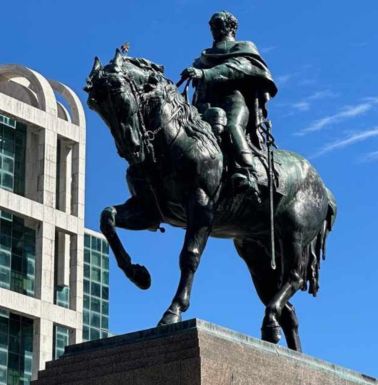
Equestrian statue of José Gervasio Artigas in Montevideo Uruguay
First, though, I stopped in Ciudad Vieja’s central and oldest square, Plaza Matriz (Plaza de la Constitución) where trees were still bare and the big fountain under repair. Enough people to be congenial, but no crowds. It’s a lovely place in summer; my teacher showed me pictures. At the smaller Plaza Zabala nearby, I found families out together, kids playing, and an appealing busker with a repertory from classical guitar to crooner songs.
A tranquil weekend. Then on Monday I started classes.
Seeing the Top Sights
I was off season, so had to watch opening times carefully. Still, I saw the most important sites, and walking along the riverside Rambla was always a sure thing. There are also dedicated, green-colored bike lanes if you fancy a bike trek.
Getting to Plaza Independencia and the Artigas monument from the hotel was via a zebra crossing. I’m familiar with them but another North American I met agreed that they were a little scary in Montevideo. Traffic does stop – have courage! But back to Artigas, the Mausoleo below the plaza is part of the memorial. It’s a big, airy space that houses Artigas’s remains in a large urn guarded by members of Blandengues de Artigas, an army cavalry regiment charged among other things with certain ceremonial duties. They have great uniforms, too, and once coming back from class I saw a changing of the guard accompanied by the regimental band. Impressive. The Mausoleo is free, and I’ve seen that it’s open until five in the afternoon (17:00), but it varied when I was there in winter. You can always come another time if the heavy chain is across the stairs.
Palacio Salvo
The next core sight is Palacio Salvo at the east end of Plaza Independencia, once South America’s tallest building. An Italian immigrant who made good in Uruguay built the Palacio as a grand hotel (it’s apartments and businesses now). The Bradt guide to Uruguay (Uruguay, by Tim Burford, 4th edition, 2022) likens the Palacio’s tower to a Jules Verne-designed rocket with booster rockets strapped to the sides. It has a shorter sibling in Buenos Aires. The finest fittings were imported from Europe, and a building tour highlights the elegant materials and artistry. (Check times for your language of choice – I just walked in and asked instead of searching online.) I was alone on the English tour, which includes the tower-top observation room (you stay inside). The view is terrific. The building is quirky, and a cone-shaped color-changing light tops the tower (blue when Uruguay has a football match, for example).
And there’s a bonus – Palacio Salvo was built on the site of the Confitería la Giralda, the café where the world’s most recognizable tango was first performed. Look up La Cumparsita on YouTube – you’ll recognize it. The Tango Museum is included in the tower tour.

Italian architect Mario Palanti designed Palacio Salvo, which was completed in 1928.
Teatro Solís
Teatro Solís, another must, is also across from the Plaza. The theater is one of the oldest in South America and of the oldest is the only one continuing an active schedule of shows. The building is a fine neoclassical opera house, seating about 1,500 in a golden-hued auditorium with an enormous crystal chandelier. The building has gone through a difficult history and various iterations, but like Palacio Salvo, it was built with the best materials. Some of the huge chandeliers are made of the original Baccarat crystals. Again, there is an English tour, and as at Palacio Salvo, I was the only anglophone.
–Hugo and Fernando at Teatro Solís!
My excellent tour guide encouraged me to go to that night’s performance. So, I grabbed a last-minute seat in the uppermost balcony with a partial view (leaning out from which gave me a sore back and neck). What a show, though! It was worth those aches. Living legends Hugo Fattoruso and Fernando Cabrera performed. A tour de force! The crowd went wild. I didn’t understand a word (yes, I did – corazón), but oh, the music. I went wild, too.
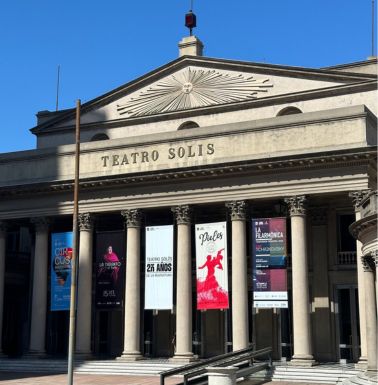
Teatro Solis is named after Juan Díaz de Solís, the first European to land in modern-day Uruguay.
Yerba Mate Culture – foundational!
Yerba mate is an herbal infusion containing caffeine, of indigenous origin, which is widely (constantly, maybe?) consumed in countries like Argentina, Brazil, Paraguay and Uruguay. Having some knowledge of its preparation, drinking, and passing among friends is a cultural key, and a cool, optional workshop at school taught us about the culture and how to prepare and drink yerba mate.
It’s traditionally drunk from a roundish calabash, or gourd (the mate), through a silver tube with a filter to strain out leaves (the bombilla). In my workshop I chose to make a traditional yerba mate and found it very bitter. I didn’t expect to be an expert at my first try; still, I grasped what was going on and learned about the different kinds of mate, different styles of bombilla, and various brands of yerba mate. This was also when I learned why so many people carry thermoses – they are always ready with hot water to refresh their brews.
After the workshop I was taking selfies on the Rambla, and a young woman offered to take my photo. I took hers in turn, and then talked about my workshop because naturally, she was enjoying yerba mate by the river on a sunny afternoon. When I mentioned the bitter taste, she pulled a packet from her backpack and suggested that I try that brand because I’d find it more pleasant. A nice encounter over selfies enriched by yerba mate.
The Rambla
Apropos of the Rambla, sloping streets from my neighborhood reach the river and the Rambla, where it’s pleasant to stroll or just sit and look at the water. This river- and seaside walkway extends 22 kilometers, about 14 miles, along the Rio de la Plata and the Atlantic, with a city view on one side and a water view to the horizon on the other. The views are better toward eastern neighborhoods like Pocitos, with parks and pretty beaches, but you can’t beat a stroll anywhere along the Rambla to clear the head. I enjoyed the wind off the water, occasional conversations, and on that first weekend, cheering with groups of parents at boys’ football (soccer) matches. In Montevideo, people consider the Rio de la Plata to be the world’s widest river as it meets the Atlantic. Others, including many geographers, call it an estuary. Whichever, it’s lovely to walk beside.
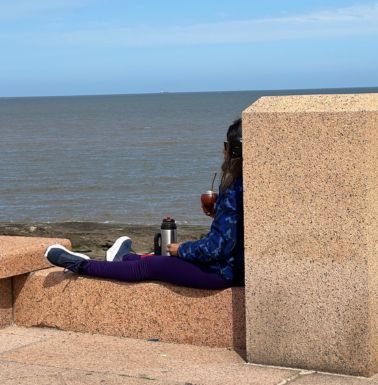
Relaxing on the Rambla.
Other Places I Managed to See During the Week
I walked by the Metropolitan Cathedral on Plaza Matriz daily but didn’t know whether I’d see inside – either it was closed, or I didn’t know how to get in. But when I first saw the big doors open, I darted inside. It’s a pretty church, larger and lighter than I would have thought. The building was consecrated in 1804 and dedicated to the Immaculate Conception and honors Saints Philip and James, the city’s patron saints. The style is Colonial Neoclassical, happily clean of excessive ornamentation. There were people clearly in earnest prayer when I visited, so I explored quietly. It was chilly; my nose got so cold on that winter afternoon as I walked around inside the church.
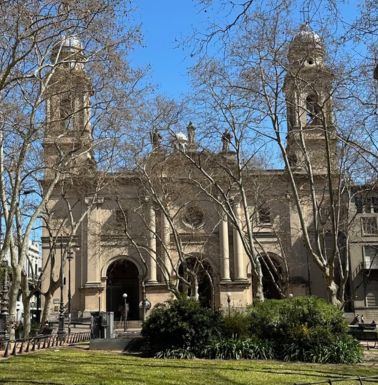
Cathedral on Plaza Matriz
The only art museum I visited was Museo José Gurevich, devoted to Lithuanian-born Constructivist artist José Gurvich (1927–74), son of Lithuanian Jews, who lived most of his life in Uruguay. An interesting artist: the museum attracted me because I’m interested in constructivism and, importantly, because it was open when other places weren’t. I also bought a cute necklace in the small gift shop. Another museum near the entrance to Ciudad Vieja is dedicated to the better known Joaquín Torres-García, who is considered the father of Latin American Constructivism. I didn’t get to that one. My oversight.
I walked by the big bookstore Librería Más Puro Verso daily on the way to school, but figured I didn’t know enough Spanish to enjoy dropping in. Then one afternoon I was finally lured in by so many books, and found a landmark building with Belle Epoque, Neoclassical, and Art Nouveau elements that once housed the first Optical and Ophthalmology institute in Uruguay. There are large, bowed display windows, a magnificent marble staircase to the second floor, a stained-glass window, and vintage clock. Books in high, wooden bookcases; classical music; a coffee shop on the second floor. It’s a great place to browse and hang out regardless of language.
Eating Around
As a utilitarian diner, I like sandwiches a lot, but now and then I do eat at restaurants. What about food in Montevideo? I ate good sandwiches, dined at my hotel, and went to two restaurants in Ciudad Vieja, all organized around my class schedule.
I visited two sandwich places more than once each – Confitería 25 de Mayo, near the school, which several people told me was their favorite bakery, and where you can get sandwiches and all sorts of baked goods. I liked the people there, too, who were nice when I bumbled Spanish and cheery when I scored small wins. And over at Palacio Salvo, close to the Radisson, there are some cafés in the street level colonnade. Based on an Internet search, I went twice to Café Social Club there, a cute coffee shop with sandwiches and pastries along with good coffee.
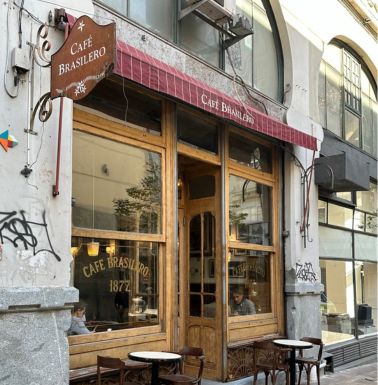
Cafe Brasilero
Sometimes I ate at the hotel, and twice I wanted a non-sandwich meal outside. First stop was Almacén Ciudad Vieja on Pérez Castellano which I chose simply because it looked nice and was filling up – a good sign. And indeed, my meal was very good, and not only that but I had a sense of cozy well-being in the restaurant on a chilly day.
I saved my other restaurant for a last day treat – Café Brasilero, the oldest café in Montevideo, dating from 1877, and a center of literary culture that has kept its Art Deco fittings and even some of the historic furnishings. As they say, “Más que un café es un espacio de inspiración.” Plus, it’s not just the oldest café in Montevideo but perhaps still is the center of local bohemian culture, with authors, tango masters, and journalists among the regulars, the most notable and longest patron being the writer Eduardo Galeano, who came every Wednesday for more than twenty years. Good food in a historic Art Deco space. My server was a delight who cheered me on when I used Spanish. And I parsed out the story of Eduardo Galeano on my placemat while awaiting my meal.
Montevideo has lots of restaurants. In Uruguay, meat has long been the focus of the best places, but culinary horizons are expanding. As usual, Internet searches will turn up great choices, especially if you like meat. For example, a quick search turned up a 2023 Eater.com article naming 23 “essential” Montevideo restaurants. And that’s just one site.
Sleeping in Montevideo
There are so many hotels, and so many reasons for choosing one. I chose Radisson Victoria, because it was close to school in the old town but situated in the modern city. Teatro Solís was five minutes away. It was also a short walk to the Rambla. There were hotel restaurants for when I wanted to dine in, and a terrific breakfast daily in Arcadia restaurant on the 25th floor; and I like a 24/7 reception. I was happy there, and whatever you want, guest house to big hotel, you’ll find it in Montevideo.
Getting around
I walked – that was it. But there are taxis, Uber, and public transportation, no underground, but buses that everyone I talked to said were safe.
There also seem to be plenty of ways to get to and from the airport. I always arrange an airport pickup when I arrive at a new town. In Montevideo, I chose Alejandro Draper, VIP Transfers, after some web searches. Excellent choice – Sophia (Mrs. Alejandro) met me in the terminal and offered sightseeing suggestions and comments on the communities and neighborhoods we passed along the pretty coastal road into downtown. I took a taxi when I left but expect that if/when I return to Montevideo, I’ll use the Drapers again.
Trip date: September, 2024
